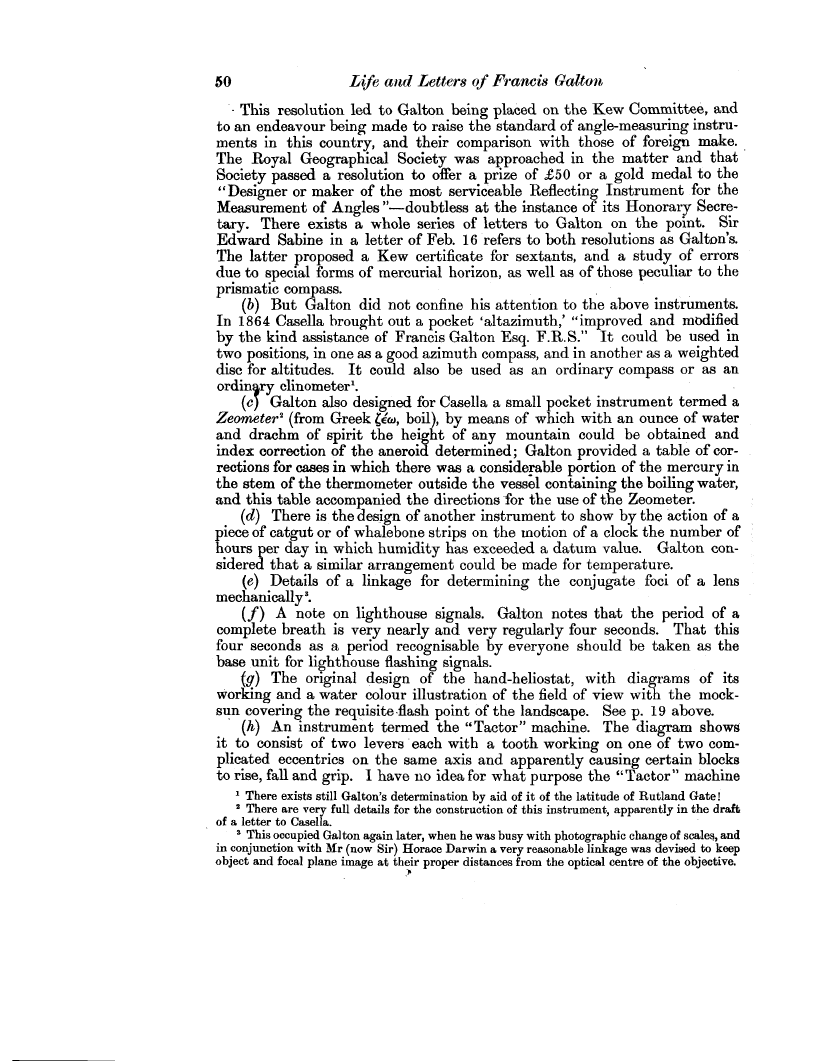50 Life and Letters of Francis Galton
This resolution led to Galton being placed on the Kew Committee, and to an endeavour being made to raise the standard of angle-measuring instruments in this country, and their comparison with those of foreign make. The Royal Geographical Society was approached in the matter and that Society passed a resolution to offer a prize of £50 or a gold medal to the "Designer or maker of the most serviceable Reflecting Instrument for the Measurement of Angles "-doubtless at the instance of its Honorary Secretary. There exists a whole series of letters to Galton on the point. Sir Edward Sabine in a letter of Feb. 16 refers to both resolutions as Galton's. The latter proposed a Kew certificate for sextants, and a study of errors due to special forms of mercurial horizon, as well as of those peculiar to the prismatic compass.
(b) But Galton did not confine his attention to the above instruments. In 1864 Casella brought out a pocket 'altazimuth,' "improved and modified by the kind assistance of Francis Galton Esq. F.R.S." It could be used in two positions, in one as a good azimuth compass, and in another as a weighted disc for altitudes. It could also be used as an ordinary compass or as an ordin ry clinometerl.
(c) Galton also designed for Casella a small pocket instrument termed a Zeometer2 (from Greek X60, boil), by means of which with an ounce of water and drachm of spirit the height of any mountain could be obtained and index correction of the aneroid determined; Galton provided a table of corrections for cases in which there was a considerable portion of the mercury in the stem of the thermometer outside the vessel containing the boiling water, and this table accompanied the directions for the use of the Zeometer.
(d) There is the design of another instrument to show by the action of a piece of catgut or of whalebone strips on the motion of a clock the number of hours per day in which humidity has exceeded a datum value. Galton considered that a similar arrangement could be made for temperature.
(e) Details of a linkage for determining the conjugate foci of a lens mechanically".
(f) A note on lighthouse signals. Galton notes that the period of a complete breath is very nearly and very regularly four seconds. That this four seconds as a period recognisable by everyone should be taken as the base unit for lighthouse flashing signals.
(g) The original design of the hand-heliostat, with diagrams of its working and a water colour illustration of the field of view with the mocksun covering the requisite flash point of the landscape. See p. 19 above.
(h) An instrument termed the "Tactor" machine. The diagram shows it to consist of two levers each with a tooth working on one of two complicated eccentrics on the same axis and apparently causing certain blocks to rise, fall and grip. I have no idea for what purpose the "Tactor" machine
1 There exists still Galton's determination by aid of it of the latitude of Rutland Gate!
2 There are very full details for the construction of this instrument, apparently in the draft of a letter to Casella.
" This occupied Galton again later, when he was busy with photographic change of scales, and in conjunction with Mr (now Sir) Horace Darwin a very reasonable linkage was devised to keep
object and focal plane image at their proper distances from the optical centre of the objective. a

